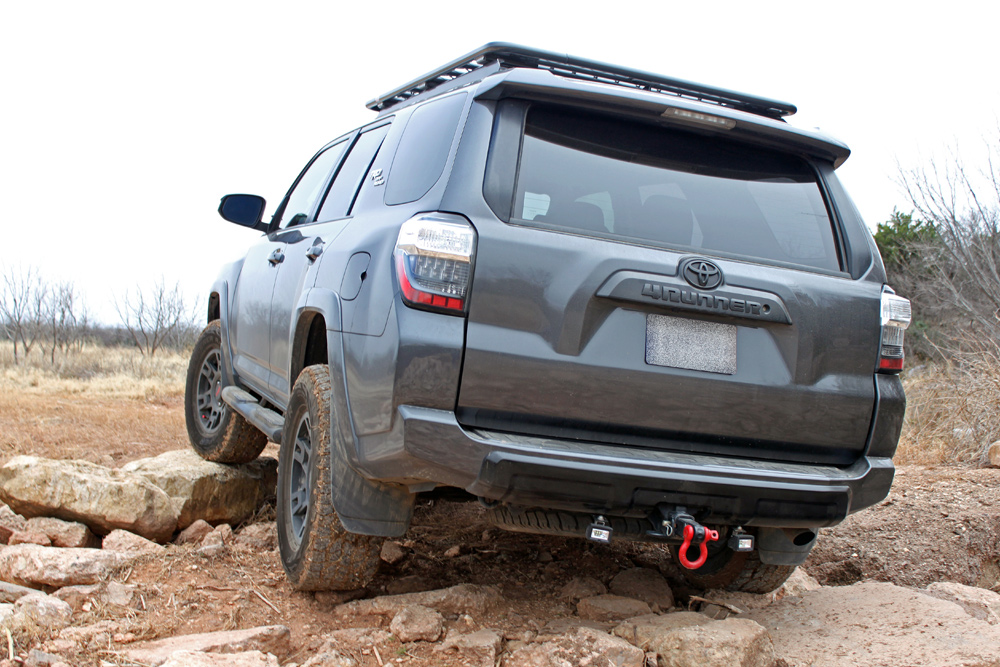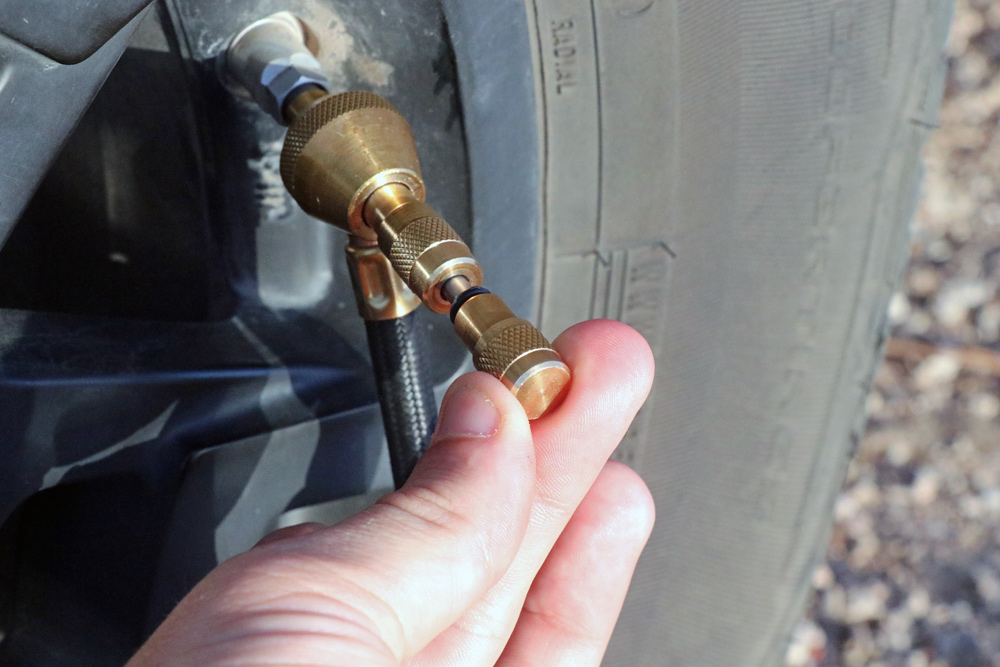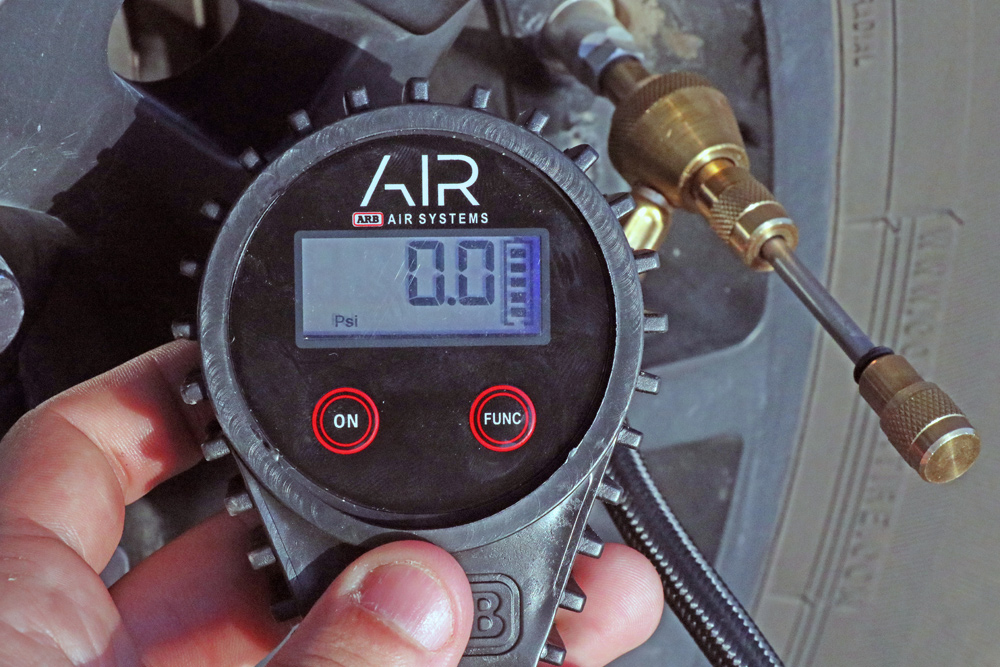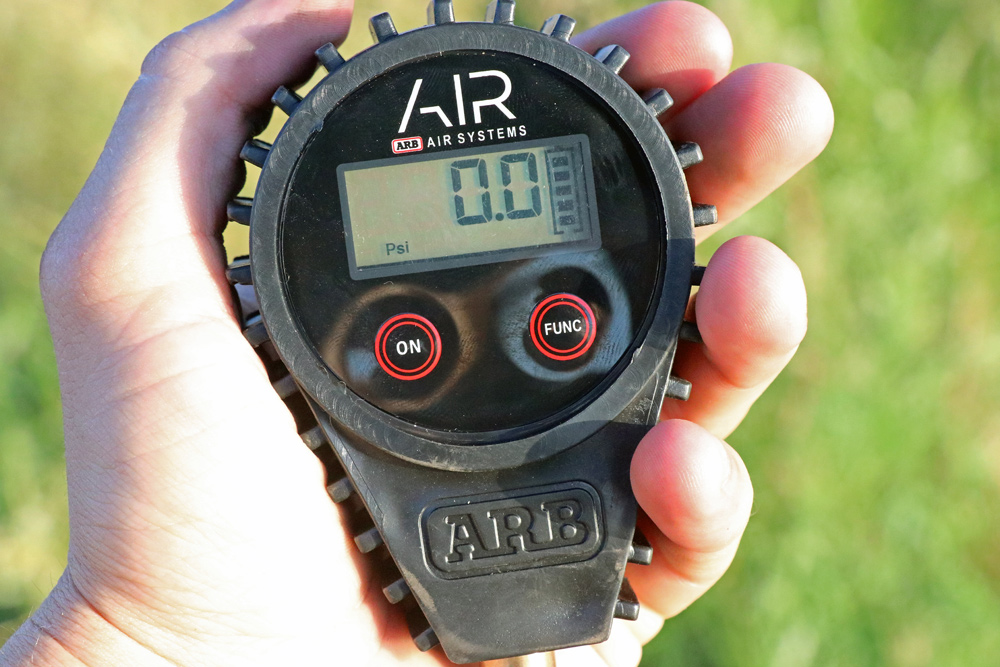
ARB Digital Tire Deflator For Lower Air Pressure While Off-Roading & Trailing in the 5th Gen 4Runner
A 5th Gen 4Runner is a trail capable vehicle right from the get-go.
If you have a TRD Off-Road (or Trail) or TRD Pro 4Runner, you are blessed with off-road goodies such as a rear locker, crawl control, and multi-terrain select.
How do you make your 4Runner more capable though?
One way is to do some off-roading upgrades. The two main upgrades that are going to give you the most bang for your buck are tires and suspension.
Unfortunately, both of these upgrades require quite a bit of money.
What if there was an upgrade that could help any vehicle become more trail capable at a much more affordable price?
Well, there is. Let’s discuss tire pressure and the ARB Digital Tire Deflator.
The ARB Digital Tire Deflator is the follow up to their already incredibly popular ARB EZ deflator which Brenan covered. Just about everyone that explores off the beaten path has used an ARB deflator, and for good reason, they work great!
There are many competitors out there but ARB is known for making some of the best off-road products on the market so when we in search for a good digital deflator, it was only right to start with ARB.
Find It Online:
- ARB E-Z Digital Tire Deflator: Check Price
Off-Road Tire Pressure 101

A stock 4Runner should run 32 psi in each tire for an overall balance of traction and fuel economy. For heavier loads, you might bump the pressure up to 35 or 40 psi.
At 32 psi, each tire has a certain footprint or area that is contacting the ground.
At lower pressures, the tire footprint becomes larger because you don’t have as much force per square inch.
What does this do?
Well, a larger footprint allows for more tread to come in contact with a surface and therefore gives you more traction.
For off-roaders, traction is key.
That is why we upgrade to all-terrain tires and higher performance suspension…so we can have better traction.
Tire pressure can also give you better traction (or worse if you are running at higher pressures).
Why Air Down?

Whether you have the best tires and suspension on the market or not, you should air down your tires when you go off-road.
Why?
- Better traction
- Better ride quality
- Increased longevity of the vehicle
So, the first and main reason you should air down is to gain better traction.
Traction is always a good thing to have. Airing down gives you much more surface area and therefore better traction.
Your tire will also be much more capable of “molding” to a surface at a lower pressure.
By airing down, you also gain a “softer” ride quality.
Smaller bumps will be absorbed much better by a tire with lower pressures than higher pressures.
When you pair tires that have been aired down with a quality suspension system such as Bilstein 6112s and 5160s, you gain an amazingly controlled vehicle off-road while still maintaining good traction.
Along the lines of better ride quality comes increased longevity of vehicle components.
A harsh ride with jarring inputs can wear out your vehicle’s components quicker than usual. Airing down gives you a smoother ride, and therefore is better for your vehicle.
These are three solid reasons to air down. The real question is how do you air down?
The ARB Digital Tire Deflator

While you can air down with a key, pen, or tire gauge from a gas station, these methods often take time and don’t give you a quick method to measure the pressure in your tires.
You typically won’t have the exact same pressure in each tire if you use this method either.
The ARB Digital Tire Deflator is an essential off-road piece of equipment that can help you air down quickly and accurately.
The ARB Digital Tire Deflator removes the valve core so that you can quickly release air from your tire.
Not only this, but a screw on chuck with a slide valve allows you to easily stop the flow of air from your tire so that you can get a pressure reading instantly…from a digital gauge.
Although you can get a good reading with a standard analog gauge, the digital gauge is quick and easy, lights up, and has around 200 hours of battery life.
All this said, the Digital Deflator isn’t much different from the standard deflator…it is just digital instead.
I think this is really nice though and definitely a benefit if you are out on the trails at night time and want a lit display.
Some of the other features of the ARB Digital Tire Deflator include auto on/off switch, rubber bump guard, carry pouch and high-quality 250mm braided line.
Features & Functionality
- Easy-To-Read Backlit Display Screen
- Battery Indicator
- Trail-Tested, Durable Rubber Bump Guard Casing
- Max Supply Pressure: 350psi, 2400kpa
- Up to 200hrs Runtime on Set of Batteries (2 X Aaa)
- Auto Switch On & Off Capability
How to Use the ARB Digital Tire Deflator
So how does this guy work?
It works similarly to that of the previous analog ARB deflator. In fact, the mechanics of the deflator are exactly the same in how it removes the valve core. The only process that differs is how you read PSI. With the digital reader, you can now visually read the exact numbers that your tires are running. You can further enhance this experience with a MORRflate 4-way inflation/deflator kit.
Let’s go through the step by step process.
Step 1. Remove Valve Cap

To begin, remove the valve cap from the valve stem.
Step 2. Push in Slide Valve & Screw on Adaptor

Make sure the slide valve is pushed all the way forward.
Then tighten the screw on the valve stem adapter to the valve stem in a clockwise motion.
Step 3. Slide Valve Core Remover Towards Valve Core

Next, push the valve core remover all the way forward until it engages the valve core.
You will feel it engage the valve core, so lightly spin the valve core remover until you feel it engage the valve core.
Step 4. Turn Remover & Apply Pressure on Valve Stem

Turn the valve core remover in a counter-clockwise motion while applying slight pressure towards the valve stem to remove the valve core. Make sure the slide valve is all the way forward (towards the tire) or else you will have a lot of air escape unexpectedly upon removing the valve core.
Step 5. Pull Slide Valve Forward To Release Air

The gauge should be reading a pressure now.
In order to release air from the tire, simply pull the slide valve towards you. To stop letting the air out, push the slide valve back forwards.
To measure the pressure in your tire the slide valve must be fully shut in the forward position.
Step 6. Push Remover into Valve Stem At Ideal Pressure

When you reach the pressure that you want to air down to, push the valve core remover into the valve stem and thread the valve core back in by turning the valve core remover handle clockwise.
Note: Do not over tighten the valve core…just make sure it is nice and snug.
Step 7. Remove Adaptor & Replace Valve Stem Cap

Remove the valve stem adapter by unscrewing it in a counter-clockwise motion.
The last step is to put your valve stem cap back on the valve stem and go off-road!
Thoughts on the ARB Digital Tire Deflator

The ARB Digital Tire Deflator works exceptionally well.
It allows you to quickly air down and do so accurately. The backlit display is a big benefit for times of low light and the digital display makes it very simple to read your pressure.
Overall, this is an awesome piece of off-road gear to throw in your recovery bag.
If you go off the beaten trail and want to improve your capability while also providing a smoother, more comfortable ride the ARB Digital Tire Deflator is a must.
It truly can help any 4Runner become more capable by simply giving you better traction.
Testing Out the Digital Tire Deflator
I recently went on a fishing trip near Mexico and I had the perfect opportunity to test out the ARB Digital Tire Deflator.
The roads consisted of rough gravel and rock so it was time to air down. I went to 25 psi so I could still drive with some speed on the rocky gravel road.
I cannot tell you how much more traction and comfort airing down gave me.
Not only this, but the ARB Digital Tire Deflator allowed me to get to the pressure I wanted quickly and accurately.
I don’t think I will ever go down a road like this without airing down.
I’ve also utilized the ARB Digital Tire Deflator to air down before going on more technical off-road sections that include steep inclines, boulders, and lots of articulation.
For scenarios like this, I like to air down to 20 psi. This pressure gives me great traction and really helps me to stay where I want to while driving off-road.
All said and done, the ARB Digital Tire Deflator is a high-quality instrument that will allow you to air down quickly and accurately.
It is worth the investment if you like to drive trails frequently.
I keep mine in my 4Runner at all times… You never know when you will stumble across the next gravel road or trail.

“A stock 4Runner should run 32 psi in each tire” tell me you’re dumb without telling me you’re dumb
Just wanted to point out that the ARB digital relies on 2AA batts, and the cheap ones that came with mine lasted only a few hours of use time. I have recently switched to Duracell alkaline. Be sure to get good batts and, if you rely on this in the field, have a spare set. I love the accuracy and ease of use of the digital over the analog so I will put up with the battery usage.
Steve, I haven’t had any battery issues with my digital gauge, but that is good information. I was originally a little bit cautious of the digital gauge (due to the batteries), but I agree…the digital gauge is quite nice in comparison to the analog gauge.
Hey Clint! Once again, great review. I did try the ARB deflator, but had to return because it couldn’t clear my beadlock style wheels far enough to fully tighten down on the air valve. The shaft wasn’t long enough. I returned and got a “beadlock friendly” digital deflator from Currie Enterprises, with longer shaft, whose initial quality seems comparable to the ARB. Thanks again for your article.
Hey Eric, sorry to hear that this deflator didn’t work with your wheel setup. I’ll have to compare to the Currie Enterprise deflator.
Good review, I purchased an analog version of the deflator some time back and found it far slower than using a tire gauge. I now use a “slime” $5 gauge which doesn’t hold the pressure reading, meaning I get an instant reading and I can go right back to letting more air out. I’ve had no problem getting to reading I want in about 1/2 the time or less than using the deflator. Nothing against these devices, they do work, just much slower and longer than using the above gauge.
Jay, that’s impressive! I haven’t found a quicker method than using this deflator. Do you have a link to the gauge you are referencing?
Clint: No link, just a cheap dial type gauge from Pep Boys. My brother purchased similar gauges at O’Reilly’s in AZ. I’ve also used a similar gauge with button release which holds the reading and it’s only marginally slower and still much quicker than the deflator I tried (Currie ?). Also I usually wheel with one of my brothers and if you stash a gauge in each door it’s 5 to 8 minutes total. Even by yourself it’s usually no more than 10 minutes. Just my 2 cents. FWIW I usually run 37 or 38 psi on stock size, passenger rated A/Ts for better gas mileage on trips and then air down to 27 or 28 for off road, 30 psi if the tire is hot. Since I don’t use E rated heavy duty truck tires I worry about the sidewalls if I go a lot lower. That psi helps a lot on bumpy gravel roads as noted by others but doesn’t trigger the air pressure warning light.
Good how-to and review! But… you CANNOT possibly generalize and say “A stock 4Runner should run 32 psi in each tire”! It depends on soooo many factors. I thought so, too, but contacted directly the manufacturer for my BFGoodrich KO2s (265/70R17, load E) and they said 44 (!!!) psi for daily driving. I drive a 2018 TRD Off-Road Premium with not much added weight (4 skid plates, winch+mounting kit, roof rack but no RTT, no frond/rear bumpers).
I was surprised at such high psi, but after doing that now I get 20 mpg combined, very even and very little wear after putting 10,000 miles on them (including hundreds of miles off-road, easy and moderate trails). Consequently, I’ve raised my psi numbers for sand, gravel, rock terrains.
I use the ARB Twin Compressor kit (mounted on a molle pannel on the passenger side) and I’m VERY happy with it — solid piece of gear allowing precise and quick PSI management.
This is actually a pretty common misunderstanding that’s been around since everything started rolling out of the factory with P-metric tires on it, while all the offroad tires are still LT-metric. LT-metric tires have a higher carrying capacity, but at a higher pressure than the same size P-metric tire, plus P-metrics have to be sized for 110% of load when used on light trucks, so there’s math and interpolation of tables involved, and even a lot of tire shops will just put in whatever the door sticker says after installing new LT tires for you.
The P265/70R17 our trucks come with are rated for 32 psi, and doing the calisthenics with the load tables gives a proper pressure of 44 psi for an LT265/70R17. The best description I’ve come across is from Toyo Tires; page 11 of their PDF:
https://www.toyotires.com/media/2125/application_of_load_inflation_tables_20170203.pdf
Thank you for bringing up this point, as the pressure will vary depending on what type of aftermarket tires you are running. For a current 5th Gen 4Runner running stock tires, the recommended tire pressure is 32 psi – but once again, going to aftermarket tires could potentially change this recommended tire pressure.
Certainly! I guess I didn’t include tires in the “stock”… Then again, I doubt any “stock” drivers read/follow this page. It’s only us, obsessively tweaking our rigs, and tires are the first, most obvious upgrade, since we tend to ride on ‘em — ideally!